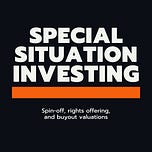You can enjoy to the Special Situation Investing Podcast on Fountain or wherever you listen.
Welcome to Episode 60 of Special Situation Investing.
Over the recent holidays, we spent many fun-filled days with our families and friends, but of course, as all true value investors do, we also spent a boat-load of time reading. In today’s episode, we’re going to share some of our top takeaways from Jeremy Miller’s book, Warren Buffett’s Ground Rules: Words of Wisdom from the Partnership Letters of the World’s Greater Investor.
While there are many good books out there on Warren Buffett, The Warren Buffett Way and The Snowball immediately come to mind, the book that is today’s focus is different than the rest of the pack in a couple ways. First, as the subtitle suggests, the book focuses solely on gleaning wisdom from Buffet’s investments during his partnership years of 1956 to 1970. This is in contrast to most books on Buffett that generally cover his entire life or focus in on his later years and investment style. And secondly, nearly half the book is Buffett’s own words as Miller pulls quotes directly from the dozens of the partnership letters.
“These ground rules are the philosophy. If you are in tune with me, then let’s go. If not, I understand.”
Officially, Buffett’s Ground Rules were a list of seven precepts that governed the relationship between Buffett and his partners. Among other things, the list included: the benchmark and timeframe against which success would be measured, how and when partners could add or withdraw funds, as well one promise Buffett could not make and three he could. (A full list of the rules can be found at this link.) Before any new partner was added, Buffett always communicated these seven principles and he harkened back to them constantly in his yearly, and then biyearly, partnership letters. Through this list, and the twenty-eight letters that gave them further color, we get a fascinating, and often entertaining, glimpse into a younger Warren Buffett’s mind and his investment process.
Takeaway #1
Our first takeaway from the book was just how mindful Buffett was of the power of incentives and how critical that was to his success.
This idea is most clearly illustrated by how Buffett deliberately structured his compensation to align himself with his partners. When they prospered, he prospered. If they didn’t, Buffet took the same losses right alongside everyone else.
The first key to this incentive structure was that Buffett had the majority of his net worth invested in the partnership, giving him massive skin-in-the-game. In fact, one of the promises that he made in the Ground Rules was that, “my wife, children and I will have virtually our entire net worth invested in the partnership.”
Another way Buffett aligned himself with his partners was by not taking a management fee for his work. Instead, the only compensation Buffett received was from gains in the partnership portfolio. This is far from how most fund managers operate today, who, on average, take a 2% fee of assets under management per year regardless of their portfolio’s performance. And to be even more fair to his partners, Buffett set a hurdle of 6% for himself, which meant that Buffett’s 25% share of the profits would only kick in on any gains in excess of 6%.
In the book, Jeremey Miller says:
The ability to design simple, easy-to-understand incentive structures has remained a key source of Buffett’s success throughout the Partnership years and indeed throughout his entire career.
It’s clear that Buffett intentionally created a system that forced him to be aligned with those who trusted him with their money. And as Miller pointed out in the quote above, Buffet also kept his system simple, and as a result reduced confusion, questions and grey areas for his partners. Today’s run-of-the-mill fund managers could learn a thing or two from the man from Omaha.
But each of us, fund managers or not, can learn from Buffett and increase our successes by using incentives as a mental model, or as Charlie Munger likes to call it, the “incentive superpower.”
In one of his quotes on incentives, Charlie says:
I think I’ve been in the top 5% of my cohort almost my entire adult life in understanding the power of incentives, and yet I’ve always underestimated that power. Never a year passes but I get some surprise that pushes a little further my appreciation of incentive superpower.
Miller sums up how and why each of us should begin following after Buffett and Munger in this mindset. He states the following:
Moreover, observing the world through the lens of incentives is a valuable tool whenever you’re trying to predict any outcome where people are involved. Incentives make the world go round. It’s helpful to think it through backward and look for ways that others will do well when you won’t, an obvious red flag.
And again, later on in the book, he says:
Once you start viewing the world through the lens of incentives, many otherwise challenging decisions become easier to make. When we know what motivates people, we pretty much know how they will behave.
We think using incentives as a mental model to improve our critical thinking and decision-making is so important, we’ll be coming back to it in future articles.
Takeaway #2
Our second top takeaway from the book was how Buffett delineated between what he considered the three types of investments. He called them Generals, Workouts and Controls.
We’ve mentioned these categories in previous episodes (in particular check out Episode 45) because we find them helpful to consider when making investment decisions.
Let’s take a look at each category one at a time, starting with Generals.
In Buffett’s own words, he defines Generals as:
A category of generally undervalued stocks, determined primarily by quantitative standards, but with considerable attention also paid to the qualitative factor. There is often little or nothing to indicate immediate market improvement. The issues lack glamour or market sponsorship. Their main qualification is a bargain price; that is, an overall valuation on the enterprise substantially below what careful analysis indicates its value to a private owner to be.
It’s worth highlighting Buffett’s use of both quantitative and qualitative factors to determine a security’s value and thus know when it is undervalued. Anyone who follows Berkshire Hathaway’s stock portfolio could easily argue that today Buffett prioritizes the qualitative over quantitative factors of value, but we found it helpful to read how in a different time and with a different amount of money to invest, Buffett often found the greatest areas of value that he could take advantage of through quantitative factors.
Moving on to the Workout category. Buffett describes them as:
Securities whose finical results depend on corporate action rather than supply and demand factors created by buyers and sellers of securities. In other words, they are securities with a timetable that we can predict, within reasonable error limit, when we will get how much and what might upset the applecart. Corporate events such as mergers, liquidations, reorganizations, spin-offs, etc.
What Buffett calls “Workouts” are often referred to as special situations today. And as you might guess from the title of our podcast, we’ve found spin-offs and other special situations a particularly fascinating subset of the investment world. Our interest in these types of investments was kickstarted when we read Joel Greenblatt’s book, You Can Be a Stock Market Genius, which is the book on the topic and thus if your interested in honing your special situation investing skills we suggest that you, one, continue listening to our podcast, of course, and two, pick up a copy of Greenblatt’s fantastic book.
What we found interesting about Buffett’s use of Workouts was how he tended to prioritize them over Generals investments during times of flat or down markets. This pivot allowed him to increase his returns even in down market years and is a lesson each of us should keep in our back pocket. Of course, what’s more important is that each of us stays within our circle of competence as far as investment style goes, but Buffett set an example to aspire to by having a large enough circle of competence that allowed him to favor one investment style over another depending on the market he was in.
Alright, let’s transition to Buffett’s third investment category, Controls. To him, these are investments where he:
either control[s] the company or takes a very large position and attempts to influence policies of the company.
Reading this book made it clear to us just how many of Buffett’s early, most successful investments fit into this category—Dempster Mills and Sandborn Maps are two examples. Perhaps this could be a bit discouraging to those of us without millions or billions at our disposal to acquire a controlling stake in companies. But one application that we took from Buffett’s success with Controls was to look for opportunities where some investor whom you trust and admire does hold a majority stake. Coat-tailing activist investors is a common practice for some investors. But one could also simply look for situations where founders, CEOs or other management, or other investors you admire do hold controlling interests.
Miller said it well. He stated:
Some of the best situations arise where you can make a significant investment of your own by some other investor is doing all the work to improve management’s decision making.
Takeaway #3
Our third, and final, takeaway was Buffett’s clear reminder that what is considered conventional is not the same thing as conservative. In a couple of the Partnership letters, Buffett responds to the question from some of the partners asking if his outperformance of the market wasn’t largely a factor of being less conservative. Buffett responds by arguing that it’s not about being conservative or aggressive, or even conventional vs contrarian. But instead it’s about being rational and being right. He wisely said:
You will be right, over the course of many transactions, if your hypotheses are correct, your facts are correct, and your reasoning is correct. True conservatism is only possible through knowledge and reason.
And later he said
We derive no comfort because important people, vocal people, or great numbers of people agree with us. Nor do we derive comfort if they don’t. A public opinion poll is no substitute for thought.
This is a great reminder. While many of us would bristle at being considered a conventional investor, the same number of us would probably consider it a badge of honor to be considered a contrarian. Buffett teaches an important lesson that neither of those are what’s important. What’s important is being rational, and ultimately being right.
To that end it’s imperative to be continual learners. As we are fond of saying, true education has no graduation. So be encouraged to read broadly and deeply. To be open to different opinions and always questioning your own. Don’t be encouraged when you are going with the crowd, or even when you are going against it. May your goal be to be rational and to be right.
With that we’ve wrapped up our top three takeaways from Jeremy Miller’s Warren Buffett’s Ground Rules. We hope you got something out of our summary and if you haven’t already, we highly suggest you pick up a copy and read the book for yourself. We believe it will be a good investment of your time.
Alright, that concludes Episode 60 of Special Situation Investing. We hope you are enjoying the show and it’s helping you become a more intelligent investor. We’ll see you all next week.










Share this post